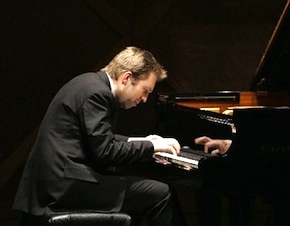
Amidst the humdrum nature of life, certain special occasions mark important events: birthdays, weddings ... or how about receiving a Nobel Prize? The sense of such an extraordinary occasion marked Thursday’s recital by the Norwegian pianist Leif Ove Andsnes at Herbst Theatre.
On first glance, his recital program seemed disjointed and unusual, consisting of Haydn and Bartók, followed by Debussy, in the first half; then Chopin waltzes and a Ballade, a Nocturne, and yet another Ballade. But it quickly became evident that Andsnes had constructed the program to illustrate precisely such a special occasion.
He opened with the Haydn Sonata Hob. XVI:20, the first of the composer’s keyboard works that include dynamics indications. No detail, no matter how small and seemingly insignificant, escaped Andsnes’ attention. The first movement may have been a tad on the sterile side, but the warm Andante movement blossomed like bouquets arrayed on long banquet tables.
There could be a debate on whether the piece should retain the characters and colors of the earlier compositions, intended to be performed on a harpsichord. Given the crescendos and diminuendos specified in the score, however, Andsnes’s approach was just on this side of the fortepiano. The bubbly final movement was a glass of champagne served to each of the guests, in white tie and ballroom gowns, as they entered the hall.
Bartók’s Suite, Op. 14, a collection of four whimsical vignettes, originally intended as a five-movement sonata, was then served as amuse-bouches. Departing from the familiar royal affairs, exotic food courses from faraway places such as Romania and Arabia were presented. However, they were not in their original, raw form, but were exquisitely prepared and meticulously arranged on the plates. Not your grandmother’s goulash, they were given a level of finesse that polished away all the rough edges. If not entirely authentic, they were presented with an unequalled level of refinement.
“Hommage à Rameau,” a sarabande, was performed with an exquisite sense of timing that breathed life into the dance.
Debussy’s Images, Book I, was the main course, on which Andsnes maintained the aristocratic elegance of the occasion. “Reflets dans l’Eau” sparkled, with every note placed deliberately. There was a level of clarity never seen in turbulent water: Every movement, every drop of water remained crystal clear, as if it were a magical water fountain in which the water doesn’t splash. “Hommage à Rameau,” a sarabande, was performed with an exquisite sense of timing that breathed life into the dance.
The final movement, simply called “Mouvement,” illustrated an intricate mechanism of the most sophisticated Swiss watch with moving gears, ratchets, and springs. Perhaps not too surprisingly, though, there was a pair of party crashers who were escorted away immediately with hardly a soul noticing them.
At the Ballroom
The second half of the program was the ball. Starting with Chopin Waltzes, the parquet floor was replete with the honored guests on their feet. The twirling rhythm added much joviality in the hall. The third Ballade that followed was the stately dance just for the King and the Queen under a spotlight, perhaps. The Nocturne Op. 62, No. 1, was intimate, but it also whispered to the guests that it was time to go. And the dramatic yet somewhat restrained Ballade No. 1 made for a puzzling end to the regal evening.
Perhaps the encores provided an answer. The joyous Waltz in A-flat Major, Op. 34, No. 1, may have been the gregarious guests outside the palace, reminiscing about the spectacular royal engagement. Granados’ Andaluza from “Danzas españolas” that followed may have been more of the partying well after midnight, at an exotic cafe, hidden away on the other side of town.
It is rare to attend a concert where I get to enjoy such an intense experience, not just from the notes being played, but also from the programming and the imaginations that the performer inspires. I went home awed but a little tired and perhaps uncomfortable from the formalwear. I look forward to attending Andsnes’s banquet again, but I would also love to run into him at the aforementioned exotic cafe, too.

